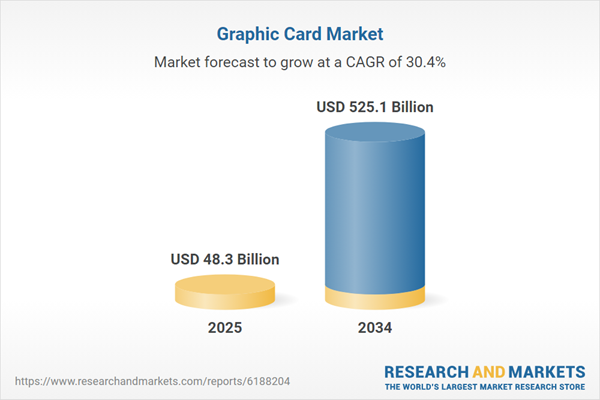Graphic Card Market Overview
The global graphic card market has emerged as a cornerstone of the modern computing ecosystem, playing a vital role in powering everything from personal gaming systems to enterprise-level AI workloads. Driven by the increasing demand for high-performance computing and immersive visual experiences, graphic cards - also known as GPUs - have evolved from niche components into essential hardware across various applications. These range from gaming, 3D rendering, and video editing to scientific simulations and cryptocurrency mining. Leading manufacturers such as NVIDIA, AMD, and Intel continue to push technological boundaries, creating GPUs with enhanced processing power, energy efficiency, and compatibility with next-gen software environments. The surge in cloud gaming, virtual reality, and AI-driven platforms has further elevated the importance of graphic cards in global tech infrastructure. As a result, the market continues to experience robust growth, supported by both consumer and enterprise segments. With increasing investment in data centers and a heightened focus on AI accelerators, the demand for high-end GPUs is anticipated to sustain its upward trajectory over the coming years.The graphic card market witnessed significant developments that highlighted its growing role in AI computing and advanced visual rendering. NVIDIA’s launch of its RTX 40 Super series with enhanced ray tracing and AI capabilities set a new benchmark for GPU performance, while AMD continued to gain traction with its RDNA 3 architecture, appealing to price-sensitive consumers and professionals alike. Intel made notable strides with its Arc GPU lineup, offering competitive mid-range options that challenged incumbent players. The gaming sector remained a strong demand driver, especially with new AAA titles optimized for real-time ray tracing and DLSS. Additionally, the generative AI boom sparked surging demand for GPUs in cloud data centers, as enterprises scaled their AI models and machine learning frameworks. On the production front, global supply chains showed signs of stabilization after previous disruptions, which helped manufacturers meet the pent-up demand. Moreover, sustainability gained attention, with vendors working toward energy-efficient chip designs to address rising concerns about power consumption and carbon footprints associated with data-intensive GPU tasks.
The graphic card market is poised to enter a phase of accelerated innovation and diversified application. The convergence of AI, gaming, and enterprise computing will continue to drive R&D investments, with chipmakers expected to unveil next-generation architectures featuring smaller nodes, faster memory interfaces, and integrated AI engines. GPU demand from the automotive sector is also anticipated to rise, as autonomous driving technologies and in-vehicle infotainment systems become more graphics-intensive. Additionally, the transition to AR and VR environments in both consumer and professional settings will foster demand for low-latency, high-fidelity rendering capabilities. Cloud-based GPU services are expected to expand, offering scalable access to powerful GPUs without the need for upfront hardware investment. Emerging markets, particularly in Asia-Pacific and Latin America, will likely experience increased adoption due to the proliferation of affordable gaming and computing solutions. Regulatory focus on chip production localization may also shift market dynamics, encouraging regional GPU manufacturing initiatives to reduce dependency on a few global suppliers.
Key Insights: Graphic Card Market
- Increased AI integration in GPUs is transforming them into multipurpose processors, enabling accelerated performance in deep learning, large language models, and real-time inference tasks.
- Cloud-based GPU-as-a-service platforms are gaining traction among enterprises, offering scalable access to high-end computing without large capital expenditure.
- Gamers are shifting toward ultra-high-resolution (4K and 8K) setups, prompting GPU makers to enhance real-time rendering and ray tracing capabilities.
- Energy-efficient GPUs are emerging as a critical design goal, with manufacturers optimizing performance-per-watt to meet sustainability targets.
- Growing demand for mobile GPUs is driving innovation in laptops and handheld consoles, balancing power efficiency and performance on the go.
- Surging popularity of e-sports and high-performance gaming continues to fuel demand for advanced GPUs that deliver immersive and lag-free experiences.
- Rapid AI and ML adoption in enterprise and academic research is generating strong GPU demand for accelerated computing capabilities.
- Expansion of the metaverse and VR/AR platforms requires high-performance GPUs to render complex 3D environments in real time.
- Increased investment in data centers and cloud computing infrastructure boosts large-scale GPU deployment for diverse workloads.
- High manufacturing costs and dependence on advanced semiconductor nodes pose barriers for new entrants and challenge pricing strategies for existing players.
Graphic Card Market Segmentation
By Type
- Dedicated
- Integrated
- Hybrid
By Device
- Computer
- Tablet
- Smartphone
- Gaming Console
- Television
- Other Devices
By Application
- Gaming
- Content Creation and Multimedia Reality
- Virtual Reality (VR) and Augmented Reality (AR)
- AI and ML
By Industry
- Electronics
- IT and Telecommunication
- Defense and Intelligence
- Media and Entertainment
- Other Industries
Key Companies Analysed
- Apple Inc.
- Samsung Electronics Co. Ltd.
- Hon Hai Precision Industry Co. Ltd.
- Intel Corporation
- Qualcomm Technologies Inc.
- Nvidia Corporation
- Advanced Micro Devices Inc.
- ASUSTeK Computer Inc.
- Micro-Star International Co. Ltd.
- GIGA-BYTE Technology Co. Ltd.
- ASRock Inc.
- Guillemot Corporation
- TUL Corporation
- Leadtek Research Inc.
- Colorful Co. Ltd.
- PNY Technologies Inc.
- Matrox Graphics Inc.
- EVGA Corporation
- Biostar Microtech International Corp.
- Palit Microsystems Ltd.
- VisionTek Products LLC
- Sapphire Technology Limited
- Zotac Technology Limited
- Club 3D
- InnoVISION Multimedia Limited
- Gainward Co Ltd.
- Diamond Multimedia
- XFX Inc.
- Albatron Technology Co. Ltd.
- STB Systems Inc.
Graphic Card Market Analytics
The report employs rigorous tools, including Porter’s Five Forces, value chain mapping, and scenario-based modeling, to assess supply-demand dynamics. Cross-sector influences from parent, derived, and substitute markets are evaluated to identify risks and opportunities. Trade and pricing analytics provide an up-to-date view of international flows, including leading exporters, importers, and regional price trends.Macroeconomic indicators, policy frameworks such as carbon pricing and energy security strategies, and evolving consumer behavior are considered in forecasting scenarios. Recent deal flows, partnerships, and technology innovations are incorporated to assess their impact on future market performance.
Graphic Card Market Competitive Intelligence
The competitive landscape is mapped through proprietary frameworks, profiling leading companies with details on business models, product portfolios, financial performance, and strategic initiatives. Key developments such as mergers & acquisitions, technology collaborations, investment inflows, and regional expansions are analyzed for their competitive impact. The report also identifies emerging players and innovative startups contributing to market disruption.Regional insights highlight the most promising investment destinations, regulatory landscapes, and evolving partnerships across energy and industrial corridors.
Countries Covered
- North America - Graphic Card market data and outlook to 2034
- United States
- Canada
- Mexico
- Europe - Graphic Card market data and outlook to 2034
- Germany
- United Kingdom
- France
- Italy
- Spain
- BeNeLux
- Russia
- Sweden
- Asia-Pacific - Graphic Card market data and outlook to 2034
- China
- Japan
- India
- South Korea
- Australia
- Indonesia
- Malaysia
- Vietnam
- Middle East and Africa - Graphic Card market data and outlook to 2034
- Saudi Arabia
- South Africa
- Iran
- UAE
- Egypt
- South and Central America - Graphic Card market data and outlook to 2034
- Brazil
- Argentina
- Chile
- Peru
Research Methodology
This study combines primary inputs from industry experts across the Graphic Card value chain with secondary data from associations, government publications, trade databases, and company disclosures. Proprietary modeling techniques, including data triangulation, statistical correlation, and scenario planning, are applied to deliver reliable market sizing and forecasting.Key Questions Addressed
- What is the current and forecast market size of the Graphic Card industry at global, regional, and country levels?
- Which types, applications, and technologies present the highest growth potential?
- How are supply chains adapting to geopolitical and economic shocks?
- What role do policy frameworks, trade flows, and sustainability targets play in shaping demand?
- Who are the leading players, and how are their strategies evolving in the face of global uncertainty?
- Which regional “hotspots” and customer segments will outpace the market, and what go-to-market and partnership models best support entry and expansion?
- Where are the most investable opportunities - across technology roadmaps, sustainability-linked innovation, and M&A - and what is the best segment to invest over the next 3-5 years?
Your Key Takeaways from the Graphic Card Market Report
- Global Graphic Card market size and growth projections (CAGR), 2024-2034
- Impact of Russia-Ukraine, Israel-Palestine, and Hamas conflicts on Graphic Card trade, costs, and supply chains
- Graphic Card market size, share, and outlook across 5 regions and 27 countries, 2023-2034
- Graphic Card market size, CAGR, and market share of key products, applications, and end-user verticals, 2023-2034
- Short- and long-term Graphic Card market trends, drivers, restraints, and opportunities
- Porter’s Five Forces analysis, technological developments, and Graphic Card supply chain analysis
- Graphic Card trade analysis, Graphic Card market price analysis, and Graphic Card supply/demand dynamics
- Profiles of 5 leading companies - overview, key strategies, financials, and products
- Latest Graphic Card market news and developments
Additional Support
With the purchase of this report, you will receive:- An updated PDF report and an MS Excel data workbook containing all market tables and figures for easy analysis.
- 7-day post-sale analyst support for clarifications and in-scope supplementary data, ensuring the deliverable aligns precisely with your requirements.
- Complimentary report update to incorporate the latest available data and the impact of recent market developments.
This product will be delivered within 1-3 business days.
Table of Contents
Companies Mentioned
- Apple Inc.
- Samsung Electronics Co. Ltd.
- Hon Hai Precision Industry Co. Ltd.
- Intel Corporation
- Qualcomm Technologies Inc.
- Nvidia Corporation
- Advanced Micro Devices Inc.
- ASUSTeK Computer Inc.
- Micro-Star International Co. Ltd.
- GIGA-BYTE Technology Co. Ltd.
- ASRock Inc.
- Guillemot Corporation
- TUL Corporation
- Leadtek Research Inc.
- Colorful Co. Ltd.
- PNY Technologies Inc.
- Matrox Graphics Inc.
- EVGA Corporation
- Biostar Microtech International Corp.
- Palit Microsystems Ltd.
- VisionTek Products LLC
- Sapphire Technology Limited
- Zotac Technology Limited
- Club 3D
- InnoVISION Multimedia Limited
- Gainward Co Ltd.
- Diamond Multimedia
- XFX Inc.
- Albatron Technology Co. Ltd.
- STB Systems Inc.
Table Information
| Report Attribute | Details |
|---|---|
| No. of Pages | 160 |
| Published | October 2025 |
| Forecast Period | 2025 - 2034 |
| Estimated Market Value ( USD | $ 48.3 Billion |
| Forecasted Market Value ( USD | $ 525.1 Billion |
| Compound Annual Growth Rate | 30.3% |
| Regions Covered | Global |
| No. of Companies Mentioned | 30 |









